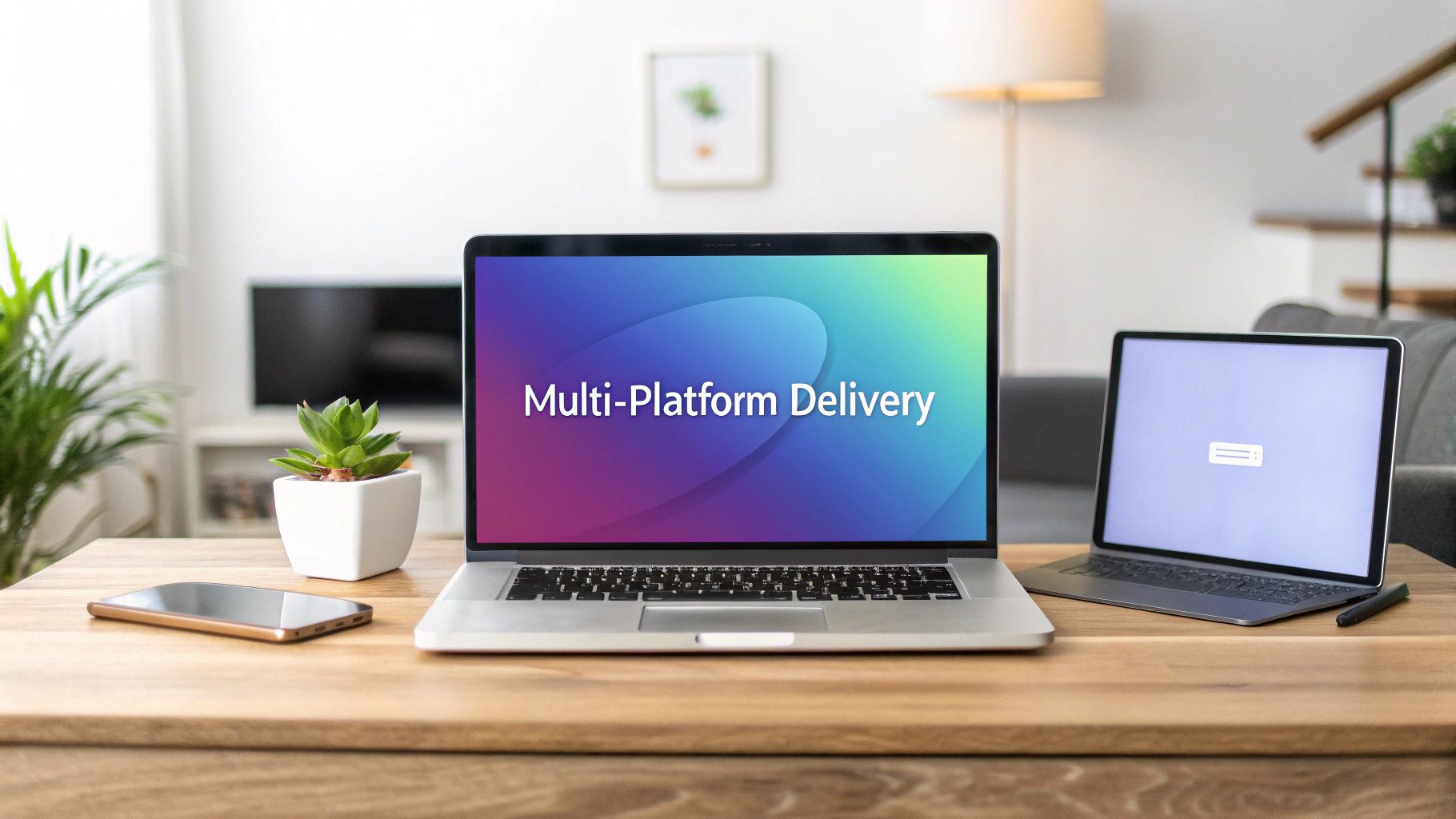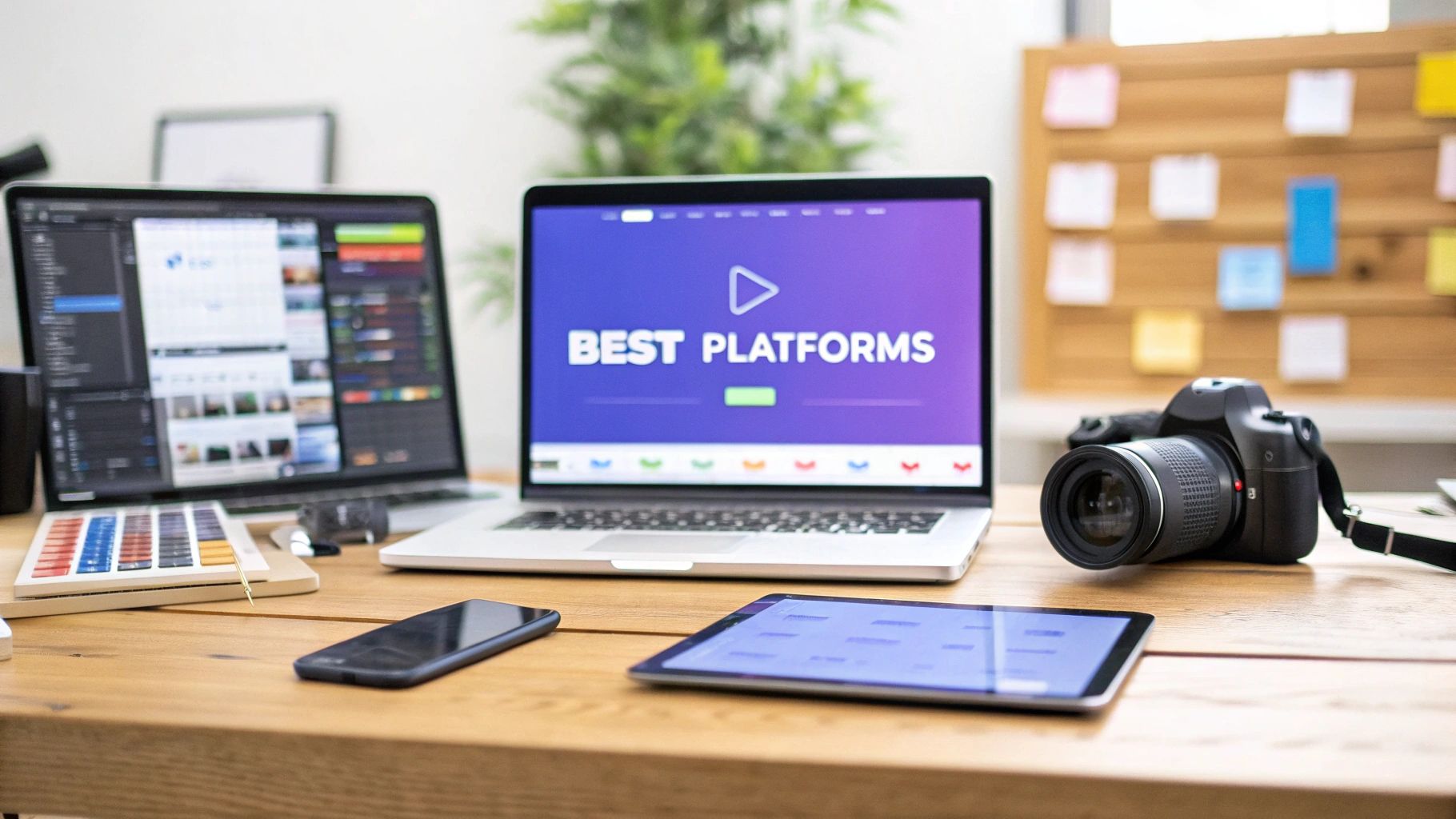What Multi-Platform Content Delivery Really Means
Think about trying to chat with someone who keeps wandering from room to room. That's what it can feel like trying to connect with your audience today. They're on Instagram on their commute, listening to a podcast at the gym, and catching news headlines on their smartwatch. Multi-platform content delivery isn't just about being everywhere; it’s about being meaningfully present where your audience actually spends their time. This means understanding not only where they are, but how they interact with content on each platform.
This shift from a single-channel approach to a multi-platform strategy requires a whole new way of thinking about content distribution. Forget simply creating great content and hoping it magically finds the right people. It's about carefully constructing a content ecosystem where each platform plays a unique role in nurturing and engaging your audience.
Understanding the Content Ecosystem
The infographic below shows how platform types, content formats, and audience touchpoints all connect in a successful multi-platform content delivery strategy.

As the infographic highlights, aligning these three elements is essential for effective content distribution. It requires a deep understanding of which content formats resonate on each platform and how to use those formats to reach specific audience segments at different stages of their journey.
The Changing Landscape of Media Consumption
The way people consume media is in constant flux. This further emphasizes why businesses need a multi-platform approach. For instance, the rise of hyperscale social video platforms like YouTube and TikTok has significantly impacted digital media trends, challenging traditional media outlets and reshaping how we consume content. People now spend over 14 billion hours on social media platforms daily, highlighting the immense reach of multi-platform strategies. To delve deeper into these evolving digital media habits, check out this insightful report from Deloitte: Digital Media Trends and Consumption Habits. This explosion in online activity reinforces the need for a solid multi-platform content delivery strategy to cut through the noise and truly connect with your target audience.
To help illustrate the core differences between traditional and multi-platform content delivery, let's look at a comparison table:
Traditional vs Multi-Platform Content Delivery Approaches A comparison showing the key differences between old-school single-channel distribution and modern multi-platform strategies
| Aspect | Traditional Approach | Multi-Platform Approach | Business Impact |
|---|---|---|---|
| Focus | Single channel (e.g., website only) | Multiple channels (e.g., website, social media, email) | Wider reach, increased engagement |
| Content Format | Often limited to one or two types (e.g., articles, blog posts) | Diverse formats tailored to each platform (e.g., videos, infographics, short-form text) | Improved content resonance, better audience connection |
| Measurement | Website traffic, page views | Platform-specific metrics (e.g., engagement, shares, conversions) | More granular insights, data-driven optimization |
| Audience Interaction | Limited, often one-way communication | Two-way communication, fostering community and dialogue | Stronger relationships, increased brand loyalty |
| Adaptability | Difficult to adapt to changing audience behavior | Agile and adaptable, allowing for quick adjustments to strategy | Greater resilience, improved ROI |
This table summarizes the key shifts required to move from a traditional to a multi-platform approach. The most significant change is the focus on diverse content formats tailored to each platform and the ability to measure success with platform-specific metrics.
Creating Interconnected Experiences
Businesses that truly excel at multi-platform content delivery don't just broadcast their message; they craft interconnected experiences that deeply resonate with their audience. This requires understanding the nuances of each platform and adapting your content to the specific context where it's consumed. By prioritizing value and meeting your audience where they are, you can build stronger relationships and maximize the impact of your content.
How Streaming Changed Everything About Content Delivery

Remember gathering around the TV for scheduled programs? It's a nostalgic image, but the reality is that broadcast schedules are fading fast. Streaming services and on-demand content are now driving how we consume media, changing the game for businesses and their content strategies.
This shift isn't just about convenience; it's about control. Viewers now expect instant access to content on their platform of choice. This new normal of platform choice has made multi-platform content delivery essential. Some companies embraced this early. Others, well, they're playing catch-up.
The New Viewing Behaviors Shaping Content
Streaming has ushered in a new era of viewing habits. Think binge-watching. Instead of waiting a week for the next episode, viewers can consume entire seasons at their own pace. This has transformed storytelling and audience engagement.
Then there's the second-screen experience. We watch TV while scrolling on our phones, engaging in a constant stream of information. This divided attention means content creators need to be more strategic about capturing and holding audience interest. They need to cut through the digital noise.
The numbers speak for themselves: 46% of viewers now prefer subscription video-on-demand (SVOD) services compared to 38% who still favor live TV. Discover more insights on multi-platform distribution. This has led broadcasters to adapt by distributing content across smart TVs, mobile devices, tablets, and even gaming consoles.
Leveraging New Consumption Patterns for Stronger Connections
Smart companies are using these new consumption patterns to build stronger relationships with their audiences. They understand that multi-platform content delivery is about more than just being everywhere. It's about crafting a cohesive experience across platforms. You might be interested in: Video Distribution Platforms.
By understanding how viewers interact with content on different platforms, businesses can tailor their message, delivering it at the right time and in the right format. This targeted approach leads to deeper engagement, stronger brand loyalty, and ultimately, better business outcomes.
This means understanding the strengths of each platform. Short videos might perform well on TikTok and Instagram Reels, while long-form content is better suited for YouTube or a company blog. This strategic use of resources is key to maximizing impact and connecting with the right audience on each platform.
The Hidden Technology Making Seamless Delivery Possible
Ever wonder what's happening behind the scenes when you click "play" and a video starts instantly? We take it for granted, but delivering content smoothly across different platforms like phones, tablets, and smart TVs is a complex undertaking. Let's explore the technology that makes this possible and learn how companies ensure their content loads quickly and plays without a hitch, no matter the device or connection speed.
Content Delivery Networks: The Internet's Expressways
Imagine driving cross-country on backroads. It would take ages! Content Delivery Networks (CDNs) are like the interstate highway system of the internet. They make sure your content takes the fastest route to your audience, wherever they are. Whether someone is watching on their phone in a remote area or streaming on a smart TV in a big city, CDNs like Cloudflare or Akamai ensure a consistent, high-quality experience.
CDNs achieve this by storing copies of your content on servers all over the world. When someone requests your content, the CDN automatically directs them to the server closest to them. This reduces latency (the delay before content starts playing) and improves overall performance. It’s like having a local shop stocking your product in every neighborhood – faster access for everyone.
Optimizing for Different Devices and Connection Speeds
Multi-platform content delivery isn't just about geography; it's also about device compatibility and connection speeds. A video that plays flawlessly on a high-speed desktop connection might endlessly buffer on a mobile device with a weaker signal. That's where adaptive bitrate streaming comes in.
Think of adaptive bitrate streaming as having different versions of your video tailored to different internet speeds. The technology automatically detects the viewer's connection speed and delivers the right version. Someone with a blazing-fast connection receives a high-definition version, while someone with a slower connection receives a lower-resolution version that still plays without interruption. This ensures a positive viewing experience for everyone, regardless of their connection.
The Economics of Content Delivery Infrastructure
Investing in the right content delivery infrastructure is essential for a successful content strategy. Building and maintaining a global network of servers is a considerable investment. However, the cost of not investing in a robust CDN can be even higher. Slow loading times and buffering issues frustrate viewers, leading to abandoned sessions and lost revenue. Think of it like investing in a reliable delivery truck – it might seem expensive upfront, but the cost of lost packages due to unreliable transportation is far greater.
Savvy companies are finding the sweet spot between performance and cost-effectiveness. They're using cloud-based CDN solutions, like those offered by Amazon Web Services or Google Cloud Platform, that offer scalability and flexibility. This pay-as-you-go model allows them to pay for the resources they need, when they need them, without breaking the bank on unnecessary infrastructure. By prioritizing a smooth user experience, these companies are building stronger audience engagement and positioning themselves for long-term success. This requires careful planning and a thorough understanding of audience behavior and the unique requirements of each platform.
To see how performance can vary across different platforms, take a look at the table below:
CDN Performance Metrics Across Different Platforms Key performance indicators showing how content delivery varies across mobile, desktop, and connected TV platforms
| Platform Type | Average Load Time (seconds) | Bandwidth Requirements (Mbps) | User Experience Rating (1-5) |
|---|---|---|---|
| Mobile | 3.2 | 2.5 | 3.8 |
| Desktop | 1.8 | 5.0 | 4.5 |
| Connected TV | 2.5 | 7.5 | 4.2 |
This table showcases the differences in average load times, bandwidth needs, and user experience ratings across various platforms. As you can see, desktop users generally enjoy faster load times and higher user experience ratings compared to mobile users, likely due to better connection speeds and larger screen sizes. Connected TVs fall somewhere in between, with higher bandwidth requirements for streaming high-quality video content.
Understanding these platform-specific nuances is crucial for optimizing your content delivery strategy and providing a seamless viewing experience for everyone.
Building Your Multi Platform Strategy That Actually Works
Creating a truly effective multi-platform content delivery strategy isn't about shouting your message from every rooftop. Think of it more like conducting an orchestra. Each platform is an instrument, playing its unique part to create a harmonious and engaging symphony for your audience. But with so many platforms competing for attention, how do you compose a strategy that truly resonates?
Defining Your Audience and Choosing the Right Platforms
The first critical step is understanding your target audience and their online habits. Where do they spend their time online? What kind of content captivates them on each platform? You don't need to be everywhere; you need to be where your audience is. Trying to maintain a presence on every platform stretches your resources and weakens your message. Instead, concentrate on the platforms most valuable to your audience and aligned with your business goals.
For example, if you're connecting with a younger demographic drawn to visuals, platforms like TikTok and Instagram Reels might be your main stage. If you're targeting professionals, LinkedIn should be a cornerstone of your multi-platform strategy.
Adapting Content Without Losing Your Core Message
Once you’ve chosen your key platforms, the next hurdle is adapting your content for each channel without sacrificing your core message. This isn't simply reposting the same content everywhere. It's about understanding the unique rhythm of each platform and tailoring your content accordingly. Consider the ideal format, length, and tone for each channel.
A long-form blog post might flourish on LinkedIn or Medium, but it needs to be distilled and repackaged for platforms like Twitter or Instagram. A short, engaging video might shine on TikTok, but it might need to be longer and richer in detail for YouTube. You can learn more about managing your video assets effectively here: Check out our guide on: Video Asset Management.
Measuring What Matters: Cross-Platform Analytics
The final piece is measuring your performance across these different touchpoints. This can be complex, as each platform has its own set of metrics. It's essential to identify the key performance indicators (KPIs) that truly reflect your objectives. Are you focused on brand awareness, website traffic, lead generation, or sales?
A content management system (CMS) can be an invaluable tool for managing and tracking your multi-platform content delivery strategy. The screenshot below offers a glimpse into a typical CMS dashboard.

This dashboard overview shows how a CMS lets you see content performance across different channels in one view. This centralized approach provides valuable insights for refining your content strategy and making data-driven decisions. Look beyond surface-level metrics like likes and shares. While these can hint at engagement, they don’t always translate into business results. Focus on metrics that directly affect your bottom line, such as website conversions, lead generation, and sales. By tracking these metrics across platforms, you can gain a complete picture of your content performance and pinpoint areas for improvement.
Learning from Success and Failure
Building a winning multi-platform strategy is an ongoing journey. Don't hesitate to experiment, monitor your results, and adapt your approach based on what works and what doesn't. Learn from both your victories and setbacks, and constantly refine your strategy to stay ahead of the game. By embracing a data-driven approach and remaining adaptable, you can create a multi-platform content delivery strategy that yields meaningful results for your business. Remember, the goal isn't to be everywhere, but to be strategically present where your audience is most receptive.
Platform-Specific Optimization That Gets Results
Imagine trying to tell the same joke at a formal dinner party that you would with your close friends. The delivery, the timing, the whole approach would be different, right? The same idea applies to multi platform content delivery. Each platform has its own unique “personality,” and successful content speaks the language of that platform fluently.
What works on Instagram might not resonate on LinkedIn. What shines on mobile could fall flat on a smart TV. This isn’t about being manipulative; it’s about understanding and respecting the nuances of each platform to ensure your message truly connects.
Understanding the Nuances of Each Platform
Think about the difference between a quick tweet and a long-form blog post. Both share information, but their style and context are vastly different. Instagram thrives on visual storytelling and short, punchy captions. LinkedIn, on the other hand, favors thought leadership articles and professional insights. Twitter thrives on real-time updates and witty banter.
A vibrant, fast-paced video might be perfect for TikTok, but the same video could feel jarring on LinkedIn, where a more polished and data-driven approach might be preferred. Understanding these subtle yet crucial differences is the key to tailoring your content for maximum impact on each platform.
Technical Requirements for Optimal Delivery
Beyond content style, the technical specifications of each platform significantly impact how your content is experienced. Mobile devices, for instance, require optimized video formats and smaller file sizes for smoother playback, especially on the go. Smart TVs, conversely, can handle larger files and higher resolutions, allowing for a richer, more immersive experience.
Imagine trying to stream a 4K movie on a slow internet connection. Frustrating, right? The same principle applies to content delivery. Neglecting the technical requirements of a platform can lead to a subpar user experience, driving your audience away.
User Experience: The Make or Break Factor
User experience (UX) is king. What engages a mobile user scrolling through their feed during their commute is different from what captivates someone watching a smart TV from their couch. Mobile prioritizes quick-loading content and easy navigation with a thumb. Smart TVs, with their larger screens and remote controls, necessitate a different design approach.
Think about trying to navigate a complex website on your phone with tiny buttons and endless scrolling. Annoying, isn’t it? The same principle applies to content. If your content is difficult to access, read, or watch on a specific platform, your audience will quickly lose interest.
Learning From the Best: Examples of Platform-Specific Excellence
Several brands have mastered the art of platform-specific optimization. GoPro brilliantly leverages Instagram’s visual nature, showcasing breathtaking user-generated content. The New York Times, meanwhile, delivers in-depth analysis and reporting on platforms like LinkedIn, appealing to a professional audience. By studying these successful strategies, you can gain invaluable insights for your own multi-platform content delivery.
Avoiding Common Pitfalls
Even seasoned content creators can fall into traps. A common mistake is simply replicating the same content across all platforms without considering the specific context of each. Another pitfall is neglecting the technical side, leading to slow loading times, formatting issues, and an overall poor viewing experience.
By addressing these potential issues proactively, you ensure that your content reaches its full potential everywhere. This thoughtful approach will help you maximize your impact and connect with your target audience on each channel effectively.
Measuring Success When Your Content Lives Everywhere

Measuring the success of your multi-platform content strategy can feel a bit like herding cats. Each platform has its own quirks, its own metrics, and its own way of defining what “good” looks like. So how do you get a handle on it all when your data is spread out across so many different places?
Identifying Key Performance Indicators (KPIs)
The first thing to do is figure out which metrics actually matter for your business. Things like follower counts and page views can be nice to see, but they don't always tell the whole story. Instead, focus on Key Performance Indicators (KPIs) that directly connect to your business goals.
For example, if you're trying to boost sales, you’ll want to keep a close eye on conversions and revenue coming from each platform. If you’re more focused on building brand awareness, metrics like reach, social mentions, and share of voice will be more important. Choosing the right KPIs gives you a clear lens through which to view your content’s impact.
Building a Unified Measurement System
Once you know what KPIs you’re tracking, you need a way to bring all your data together. This might involve using a dedicated analytics dashboard like Google Analytics, integrating platform-specific APIs, or a combination of tools. The goal is to centralize everything so you can see the forest for the trees.
Having this unified view allows you to identify trends and patterns across all platforms. You can see which content is hitting the mark, which channels are driving the most valuable traffic, and where you might need to tweak your approach. It's like having a command center for your content strategy.
Analyzing Cross-Platform Data
Just having all the data in one place isn’t enough; you have to actually analyze it to find useful insights. Look for connections between different platforms. For example, are more social media shares leading to more website visits? Is one type of content doing particularly well on a specific platform, hinting that it could be adapted for others?
By digging into the data this way, you can start to understand how your different content channels work together. This lets you refine your strategy, focusing on what's working and moving away from what isn't. It's all about continuous improvement.
Avoiding Analytics Traps and Making Informed Decisions
It's easy to get lost in the weeds with all those numbers. Try not to overreact to short-term ups and downs; instead, focus on long-term trends. Experimentation is important, but always measure the impact of your experiments so you can learn and adapt.
For example, if you try a new content format on one platform, track its performance closely. Did it achieve what you were hoping for? If not, what can you learn from the data to make it better? This back-and-forth process of testing and refining is essential for optimizing your multi-platform strategy. By steering clear of common analytics pitfalls and focusing on actionable information, you can set your content strategy up for long-term success.
Future-Proofing Your Content Delivery Strategy
The online world never sits still. What’s hot today might be yesterday’s news tomorrow. So, how can you build a content strategy that adapts to the constantly shifting landscape of multi-platform content delivery, without needing a complete rebuild every few months? This section explores the key trends, technologies, and guiding principles that will help you stay ahead of the game.
Embracing Emerging Technologies
Artificial intelligence (AI) and machine learning aren't just science fiction anymore; they're quickly becoming essential tools for content distribution. Imagine AI as your super-efficient assistant, personalizing content recommendations, optimizing delivery times based on how your audience behaves, and even automating parts of the content creation process.
This means your content can be more targeted and effective, reaching the right people at the right moment with precisely the message they need. For a more detailed explanation of how AI is changing video marketing, check out this resource: Learn more in our article about: AI Marketing Video. These developments will continue to reshape multi-platform strategies, making them more adaptable and responsive to your audience.
The Power of Adaptability
Building flexibility into your content delivery strategy is crucial for navigating the changing digital world. This doesn't mean abandoning what you’re already doing; it means creating a framework that lets you change direction quickly when new opportunities appear. Think of it like building a house with movable walls – you can easily reconfigure the layout to fit changing needs without demolishing the entire structure.
A core part of adaptability is platform diversification. Don't put all your eggs in one basket. While it's important to focus on your main platforms, exploring new channels allows you to connect with new audiences and stay ahead of the competition. This might involve testing new social media platforms, exploring different content formats like short videos or long-form articles, or even venturing into virtual or augmented reality.
Staying Focused on Core Principles
While technology and platforms may change, the fundamental principles of successful content delivery remain constant. Creating high-quality content that resonates with your audience will always be king. This means understanding their needs, what they're interested in, and the problems they're facing.
Consistent branding and clear communication across all platforms build trust and reinforce your message. Just as a strong foundation is crucial for any building, a robust content strategy rooted in these core principles will empower you to adapt and thrive in the ever-evolving digital environment. This emphasis on quality and consistency ensures your content stays relevant and engaging, no matter which platforms you use.
Preparing for the Next Wave of Digital Transformation
Forward-thinking companies are already getting ready for the future of multi-platform content delivery. They're exploring new technologies, studying user data to spot emerging trends, and building adaptable teams that can adjust quickly to change.
These companies realize the future of content delivery isn't about simply being everywhere, but about strategically selecting the right platforms and tailoring content to resonate with each specific audience. They’re also focused on building communities and creating two-way conversations with their audience. This approach strengthens relationships and builds more meaningful connections with customers.
Ready to transform your video content creation process? Sprello's AI-powered platform enables you to create engaging, user-generated-style ads quickly, without needing actors or complicated editing. Explore Sprello and start creating today!



